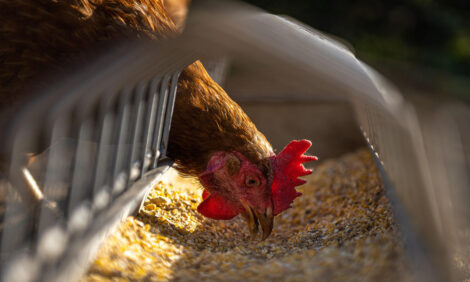



Advanced Molecular Technology Helps to Pinpoint IB Variants and Improve Vaccination Programmes
By comparing sequences of commercial infectious bronchitis (IB) vaccine strains to those in the field, it is possible to determine if an IB field strain is identical to a vaccine IB strain or different in a defined way, according to Richard Currie, PhD, BVM&S, MRCVS, in the Journal of Poultry Respiratory Protection from Merck Animal Health, US.Advances in molecular technology now make it possible to pinpoint the strains of infectious bronchitis (IB) affecting poultry flocks and to tailor a vaccine programme that can more effectively control the disease, according to a leading poultry veterinarian with expertise in molecular diagnostics.
“You have to know the nature of the field challenge to design a vaccination programme capable of protecting,” says Richard Currie, PhD, BVM&, MRCVS, president of x–OvO Limited, Scotland, a biotechnology company that performs diagnostics for many poultry companies in Europe.
“In addition, to be cost–effective, you want to use as many vaccines as you need – but not more than you need. Appropriate molecular diagnosis of IB infections gives you that option,” he says.
Complicated Diagnosis
The diagnosis of IB infection is complicated, in part, Dr Currie explains, because of many diverse IB viruses present in the field. IB is an RNA virus and RNA viruses easily undergo genetic changes.
Testing for IB viruses is also an expense, and in the current economic climate, many producers often prefer to limit costs until a major clinical problem occurs. When producers do request IB diagnostic tests, they usually opt for serological–based tests that are conducted on a more or less routine basis, but the sample sizes tested make this of relatively limited diagnostic value, he says.
New, pre-packaged polymerase chain reaction (PCR) tests can reveal whether a particular subtype of IB is present, but they can’t differentiate between vaccine and field strains nor can they identify emerging new IB strains. “You can only find what you know already exists,” Currie says.
‘Indispensible’ Testing
|
* "…the presence of these types of viruses can indicate to the veterinarian that a stronger, broader–protective vaccination strategy is more appropriate." |
Dr Richard Currie |
In contrast, molecular investigation using real–time quantitative PCR testing plus sequencing of the S1 gene of IB virus not only allows specific identification of the virus that is present, it also provides several practical ways that veterinarians can alter the way a flock is managed to optimise health status and performance, he says.
“In fact,” Dr Currie says, “there are poultry veterinarians who now consider PCR testing an indispensable part of their clinical approach to IB.”
The newer technology makes it possible to identify novel IB viruses, determine the quantity of IB virus present and compare the efficacy of different vaccine application methods.
Studies by x–OvO, in collaboration with MSD Animal Health, have demonstrated that more IB vaccine virus replicates in birds vaccinated by the spray route compared to administration of the vaccine in water, Dr Currie says.
By comparing sequences of commercial IB vaccine strains to those in the field, it is possible to determine if an IB field strain is identical to a vaccine IB strain or different in a defined way, he continues.
“These differences can be significant because there are specific changes that are associated with a breakthrough in vaccine protection. Hence, the presence of these types of viruses can indicate to the veterinarian that a stronger, broader–protective vaccination strategy is more appropriate,” Dr Currie says.
The resulting information can help veterinarians determine if flocks would benefit from using a combination vaccine approach, such as Nobilis IB Ma5, which is based on the Massachusetts IB serotype, and Nobilis IB 4/91, which is based on the IB 4/91 variant serotype, he adds.
Monitors Trends
The newer molecular technology now used by x–OvO also makes it possible to identify important trends in the field that can guide poultry veterinarians and producers, according to Dr Currie.
It enabled the first diagnosis of the Chinese IB QX–variant genotype outbreak and subsequent epidemic in the UK. “This would have been missed with the previous technologies,” he says, noting that trends in the IB viruses circulating tend to be the same whether it is the layer, breeder or broiler segment of the market in a given area.
The technology made it possible to demonstrate that suspected field outbreaks of IB QX in German flocks vaccinated against IB QX with a live QX vaccine were due to QX field infection – not simply to the detection of the live QX vaccine.
“Older technologies would simply have confirmed the presence of IB QX and everyone would have thought it was the vaccine,” Dr Currie says.
For French flocks, the combination of PCR testing and extensive IB haemagglutination testing of sera samples clearly showed the presence of an IB 4/91 serotype field challenge in flocks vaccinated only with an IB H120 vaccine. “This is a good application of the technology, clarifying serological results with a molecular confirmation test, and it justified the need for changing the vaccination programme,” he says.
The technology further demonstrated that the IB Italian 02 variant, which was a major problem in the EU some eight years ago, has almost disappeared from the area, he notes.
Testing with Service Package
Another advantage, Dr Currie says, is that veterinarians who collaborate with certain animal health companies, such as MSD Animal Health, gain access to molecular diagnostics as part of a service strategy that supports appropriate vaccine use.
For molecular diagnostics, x–OvO prefers that tracheal and cloacal swabs be submitted; they provide larger amounts of intact viral RNA, and the company can provide the permits necessary for sending clinical material for testing, he says.
FTA cards can be used for submission of samples from countries where the export of genetic material is not allowed by local authorities; the cards inactivate and stabilise genetic material but the technique required to remove RNA from the cards can sometimes lower diagnostic sensitivity, Dr Currie says.
If uncomplicated testing is all that is required, which is the case with most submissions, results are guaranteed a maximum of 21 days from submission; they come with an analytical report that puts the results into a clinical context that veterinarians can use. Sometimes, when dual infections are involved, further analyses may be necessary and the results are sent as they become available, Dr Currie says. The goal is to customise the format of the results so they emphasise issues that are critical to the client.
There is another important benefit that advanced molecular technology brings to the poultry industry, he says. With the tracking abilities it affords, the technology can help define the epidemiology of IB viruses in a certain region or country, which enables the poultry industry to make better use of the IB vaccines that are available and tailor vaccination protocols as needed.
Additional information about x–OvO Limited’s diagnostic services is available on the company’s web site.
Further Reading
|
| - | Find out more information on infectious bronchitis by clicking here. |
March 2012









